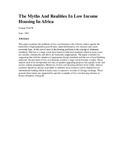| dc.contributor.author | Syagga, Paul M | |
| dc.date.accessioned | 2013-06-03T06:41:37Z | |
| dc.date.available | 2013-06-03T06:41:37Z | |
| dc.date.issued | 1987 | |
| dc.identifier.uri | http://cae.uonbi.ac.ke/uon_publications/author/2130 | |
| dc.identifier.uri | http://hdl.handle.net/11295/28545 | |
| dc.identifier.uri | http://www.africabib.org/rec.php?RID=119539284 | |
| dc.description.abstract | This paper examines the problems of low-cost housing in the African context against the backcloth of high population growth rates, rapid urbanization, low incomes and a poor economic base. At the root of most of the housing problems is the concept of minimum standards. This has to a large extent been based on inherited standards which in many cases are socially, climatically and above all financially inappropriate. The paper concludes by suggesting that with the adoption of appropriate design standards and the use of local building materials, the provision of low-cost housing would to a large extent become a reality. These aspects need to be incorporated not only in squatter upgrading projects, but equally in site and service scheme programmes. Moreover, for low-cost housing schemes to be viable, African countries should try insofar as possible to mobilize local resources and to depend less on international funding which in many cases is expensive in terms of foreign exchange. These general observations are supported by specific examples of low-cost housing schemes in Kenya (Dandora, Umoja II) | |
| dc.language.iso | en | en |
| dc.title | The Myths And Realities In Low Income Housing In Africa | en |
| dc.type | Presentation | en |
| local.publisher | Real Estate and Construction Management, University of Nairobi | en |

